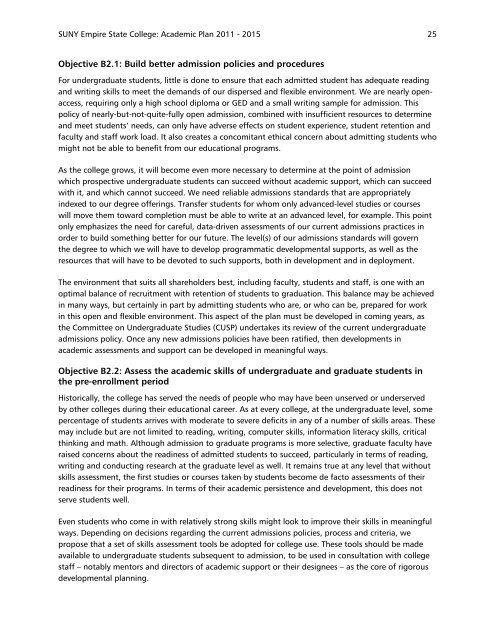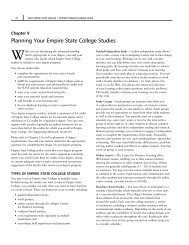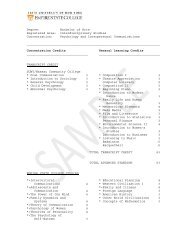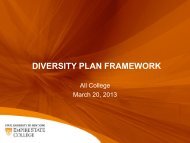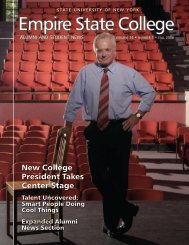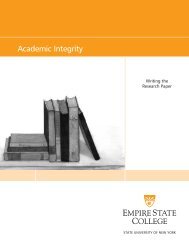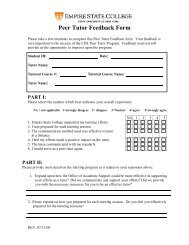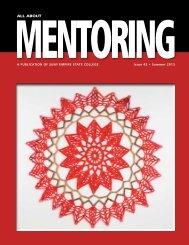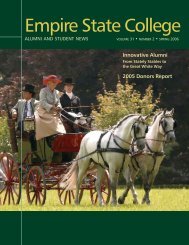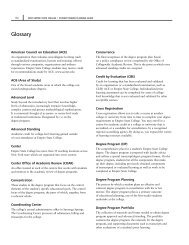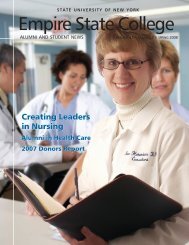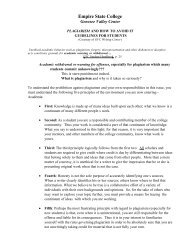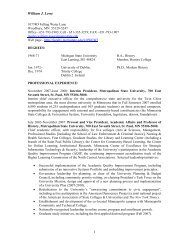Academic Plan 2011-2015 (PDF 524kB) - SUNY Empire State College
Academic Plan 2011-2015 (PDF 524kB) - SUNY Empire State College
Academic Plan 2011-2015 (PDF 524kB) - SUNY Empire State College
You also want an ePaper? Increase the reach of your titles
YUMPU automatically turns print PDFs into web optimized ePapers that Google loves.
<strong>SUNY</strong> <strong>Empire</strong> <strong>State</strong> <strong>College</strong>: <strong>Academic</strong> <strong>Plan</strong> <strong>2011</strong> - <strong>2015</strong> 25Objective B2.1: Build better admission policies and proceduresFor undergraduate students, little is done to ensure that each admitted student has adequate readingand writing skills to meet the demands of our dispersed and flexible environment. We are nearly openaccess,requiring only a high school diploma or GED and a small writing sample for admission. Thispolicy of nearly-but-not-quite-fully open admission, combined with insufficient resources to determineand meet students’ needs, can only have adverse effects on student experience, student retention andfaculty and staff work load. It also creates a concomitant ethical concern about admitting students whomight not be able to benefit from our educational programs.As the college grows, it will become even more necessary to determine at the point of admissionwhich prospective undergraduate students can succeed without academic support, which can succeedwith it, and which cannot succeed. We need reliable admissions standards that are appropriatelyindexed to our degree offerings. Transfer students for whom only advanced-level studies or courseswill move them toward completion must be able to write at an advanced level, for example. This pointonly emphasizes the need for careful, data-driven assessments of our current admissions practices inorder to build something better for our future. The level(s) of our admissions standards will governthe degree to which we will have to develop programmatic developmental supports, as well as theresources that will have to be devoted to such supports, both in development and in deployment.The environment that suits all shareholders best, including faculty, students and staff, is one with anoptimal balance of recruitment with retention of students to graduation. This balance may be achievedin many ways, but certainly in part by admitting students who are, or who can be, prepared for workin this open and flexible environment. This aspect of the plan must be developed in coming years, asthe Committee on Undergraduate Studies (CUSP) undertakes its review of the current undergraduateadmissions policy. Once any new admissions policies have been ratified, then developments inacademic assessments and support can be developed in meaningful ways.Objective B2.2: Assess the academic skills of undergraduate and graduate students inthe pre-enrollment periodHistorically, the college has served the needs of people who may have been unserved or underservedby other colleges during their educational career. As at every college, at the undergraduate level, somepercentage of students arrives with moderate to severe deficits in any of a number of skills areas. Thesemay include but are not limited to reading, writing, computer skills, information literacy skills, criticalthinking and math. Although admission to graduate programs is more selective, graduate faculty haveraised concerns about the readiness of admitted students to succeed, particularly in terms of reading,writing and conducting research at the graduate level as well. It remains true at any level that withoutskills assessment, the first studies or courses taken by students become de facto assessments of theirreadiness for their programs. In terms of their academic persistence and development, this does notserve students well.Even students who come in with relatively strong skills might look to improve their skills in meaningfulways. Depending on decisions regarding the current admissions policies, process and criteria, wepropose that a set of skills assessment tools be adopted for college use. These tools should be madeavailable to undergraduate students subsequent to admission, to be used in consultation with collegestaff – notably mentors and directors of academic support or their designees – as the core of rigorousdevelopmental planning.


